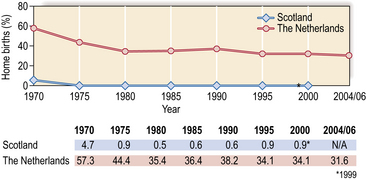Chapter 2 Pregnancy and childbirth
This textbook appropriately starts at the beginning of life, at birth. It is also appropriate to use one of the most natural life events as an introduction to the behavioural sciences. The birth of humans differs from births in other mammals in our social construction of the event. Social behaviour is guided by institutions and customs, not merely by instinctual needs, and perhaps nothing illustrates this basic sociological principle better than the sheer diversity of human practices at the time of childbirth, and their responsiveness to historically changing influences. In other words, where and how and in whose presence a woman gives birth differ from one social setting to another. Human societies everywhere prescribe certain rituals and restrictions to pregnant and labouring women. For example, the place of delivery is often prescribed, be it a special village hut or a special obstetric hospital.
The nature of pregnancy and childbirth
There are two major contrasting views on the nature of pregnancy and childbirth (Table 1). One argues that these are normal events in most women’s life cycle. This is often referred to as the psychosocial model. It is estimated that some 85% of all babies will be born without any problems and without the presence of a special birth attendant. Many of the risks in childbirth can be predicted and, consequently, pregnant women most at risk can be selected for a hospital delivery in a specialist obstetric hospital. The remainder of pregnant women can opt for a less specialist setting such as a delivery in a community hospital or a home delivery. A proponent of this view is Tew (1990), who discovered, to her own surprise whilst preparing epidemiological exercises for medical students in Nottingham, that routine statistics did not support the widely accepted view that increased hospitalization of birth had caused the decline in mortality of mothers and their babies.
| Model | ||
|---|---|---|
| Psychosocial | Biomedical | |
| Childbirth normal/natural until pathology occurs | Childbirth only normal in retrospect | |
| Emphasis | Normality | Risk |
| Social support | Risk reduction | |
| Woman = active | Woman = passive | |
| Health | Illness | |
| Individual | Statistical | |
Secondly, the view most commonly held in nearly all western societies is that pregnancy and particularly labour are risky events, where things could go wrong. This is referred to as the biomedical model. Childbirth is, therefore, potentially pathological. Since we do not know what will happen to an individual pregnant woman, each one is best advised to deliver her baby in the safest possible environment. The specialist obstetric hospital with its high-technology screening equipment supervised by obstetricians is regarded as the safest place to give birth. In short, pregnancy and childbirth are only safe in retrospect. Consequently, the majority of deliveries occur in hospital. Figure 1 contrasts the percentage of home births in the Netherlands with Scotland, where Scotland reflects the trend in most industrialized countries.
Stay updated, free articles. Join our Telegram channel

Full access? Get Clinical Tree



